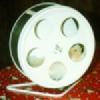 |
Wodent Wheel Comments |
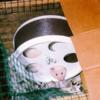 |
 |
Wodent Wheel Comments |
 |
In late November of 1997 we bought Buttermilk an exercise wheel called the "Wodent Wheel". The Wodent Wheel seems to be a significant enough product that I decided to devote a page to my pictures and comments about it.
For those who don't feel like reading the whole page,
On the down side, the ball surface seemed to attract dirt, and it was a pain to clean. Further, if Paul did not want to come out, I had to take the ball off the stand, remove the cover, get him out, and put everything back together. It also seemed to me that the inside of the ball -- made of smooth plastic -- was not a very good running surface; the only traction was provided by small slits.
I don't want to run down the ball too much. It's a pretty good idea, and Paul did much better with it than he did with the wire wheel. The ball also has the advantage of doubling as an in-the-cage exercise "wheel" and an out-of-the-cage ball, an important factor for those with small budgets. Still, I like the Wodent Wheel better, as you'll see.
When Paul died and we got our second hamster, Percy, in 1995, we went back to the wire wheel, since we were tired of the always-messy ball. Percy did much better than Paul on the wheel, but later in his life we found the same sores on his legs. This time I threaded cardboard through the rungs of the wheel. Percy's legs didn't fall through the rungs any more, but the wheel became too heavy. The cardboard surface was also rather slippery, offering little traction.
Our third hamster, Buttermilk, adopted in June 1997, got the bare wire wheel again. And again, his feet slipped through the rungs. Buttermilk was able to keep from injuring himself by only walking on the wheel. After his first month or two he never went very fast on the wire wheel. Seeing the problem, I threaded paper through the rungs. Buttermilk was noticeably less happy with things. The paper offered less traction, and his feet still occasionally fell through; every few days I had to patch up a rip in the paper.
Thus, I was interested when I read some comments about the Wodent Wheel from some satisfied customers on alt.pets.hamsters in the fall of 1997. It was described as a hamster exercise wheel with a textured running surface and no holes for feet to fall through. This struck me a something that had been needed for many years. I checked out the web page, and, in late November, I asked for comments from the newsgroup. The consensus was that the Wodent Wheel was a very good product. Of the three sizes -- Junior, Senior, and "Wobust" -- the one recommended for hamsters was the Junior.
Three days later, the Wodent Wheel arrived in the mail. It came preassembled, although it's easy to take apart and put back together. The wheel itself is plastic, while the wingnut, washer, and stand/axle are metal. The running surface is 8 inches in diameter, and the entire unit is 8 and 7/8 inches tall when standing up. The general shape of the wheel is rather like a drum. The two sides are made of flat white plastic. They are identical, except that one side has five circular hamster-sized holes, while the other side has no holes.
The running surface, which has no holes, is brown plastic and is rather rough. Visually, it reminds me of a cedar board, but it doesn't feel like one; there are no sharp pieces sticking out, and no splinters break off -- I tested this by running my hand along it. It strikes me as a better running surface than any of those I described above. It seems easier to clean than the ball-on-a-stand. Or maybe Buttermilk is just less messy than Paul -- it's tough to say.
The stand is a painted bent metal rod -- all one piece. On the side of the wheel with no holes, the rod goes through a washer and through the center of the wheel to form an axle. On the side with the holes, the wingnut is on the axle.
When we introduced Buttermilk to the wheel, he sniffed it thoroughly. After a minute or two he hopped inside. A couple of minutes later he was running away like an old pro. He was running, not walking. He would run for 30 to 60 seconds, stop, poke his head out of one of the holes, sniff a few times, then go back to running. He still does this when he's running and I'm around. (Of course, I don't know what he does when I'm not around.)
There is one small gap in the brown running surface. It's not a hole, but a strip of white plastic. This makes it easy to count revolutions and see how fast Buttermilk runs. For all you non-mathematical people with Wodent Wheels, count the number of revolutions over a period of time, measured in seconds. Divide the number of revolutions by the number of seconds, then multiply by 1.43 to get miles per hour or 2.30 to get kilometers per hour. (This is for the Wodent Wheel Junior. For the W. W. Senior, the numbers are 1.96 and 3.16. For the Wobust W. W., they are 2.14 and 3.45.) I counted 61 revolutions in 45 seconds. So Buttermilk was running at a bit under 2 mph.
Ever since, Buttermilk runs on the wheel a lot. He used his old wheel a lot, but he didn't run very much. The wheel also makes a nice hamster hidey-hole -- it's almost totally enclosed -- so Buttermilk likes just sitting in it, too.
Now, this last fact is great for Buttermilk, but it worried me slightly. I foresaw two possible problems stemming from Buttermilk liking the wheel too much. First of all, I wondered whether it would be difficult to get him out. It turns out to be about the same difficulty as for the wire wheel, and significantly easier than for the ball-on-a-stand. He will be sitting by one of the five holes. I put my fingers in the holes on either side, and out he comes; or, if he's feeling particularly stubborn, it's easy to push him out. (Note that sticking my fingers in like this might present a problem if Buttermilk were fond of biting; of course, I would have a similar problem with other enclosed exercise wheels.)
A second concern was whether Buttermilk would set up housekeeping using the wheel, using it as bed, pantry, or toilet. He has not done any of these, fortunately. I don't know how common it is for hamsters to treat the wheel like this, and, again, this would be a problem for the ball-on-a-stand and other enclosed exercise wheels, as well.
My wife tells me that Buttermilk has some things to say about the wheel. Unfortunately, I can't understand hamster speech, so I have to rely on her:
Here is Buttermilk's endorsement of the product. "It is great! I can poke my head out the side to look out. My little legs are happy, because they don't keep falling through and getting banged up." :)And there you have it.
In conclusion, the Wodent Wheel is a good product. I like it, my hamster likes it, and I recommend it.
One final note: the people who run the Wodent Wheel place (the company is called "Transoniq") apparently keep rodent pets. When I called, I was told that the regular order takers were not there, since they were "taking the rat to the vet".
When ordering, I suggest you get the wingnut style. The proper size for hamsters is the Wodent Wheel Junior. For more information, see the Wodent Wheel Homepage.
Here is Buttermilk checking out his new Wodent Wheel. He is cautious at first, but soon he is madly sprinting away.
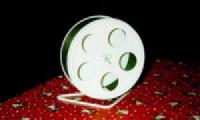
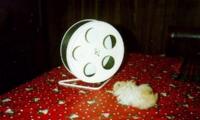
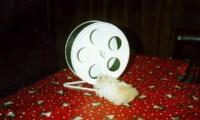
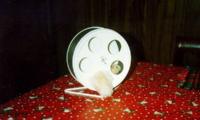
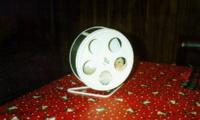
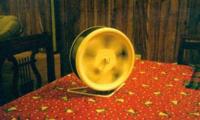
After running for a minute or so, Buttermilk stops to see how far he has gone.
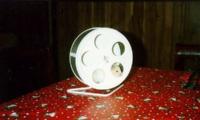
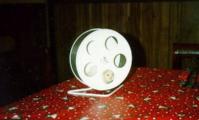
Below is the Wodent Wheel, still containing Buttermilk, positioned in Percy's Palace (our hamster cage).
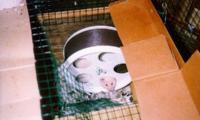
Back to Glenn's Hamster Page.